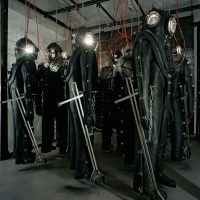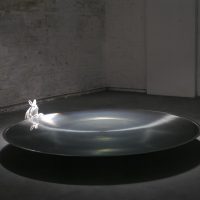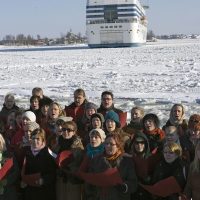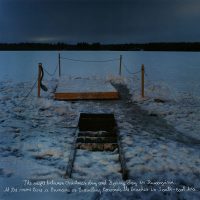Szilikon, fém, motorok, pneumatika, hang / Silicon, metal, motors, pneumatics, sound
300 x 300 x 300 cm
Jenny and Antti Wihuri Foundation
Kitömött nyúl, rozsdamentes acél, pumpa, víz / Stuffed hare, stainless steel, pump, water
52 x 250 cm (átmérő a legszélesebb ponton)
Wäinö Aaltonen Museum of Art – Turku City Art Collection
Videoinstalláció / Video installation
Teljes hossz 55 perc / Duration in total 55 minutes
A művészek jóvoltából / Courtesy the artists
Helyspecifikus fotóinstalláció, C-printek / Photographic site specific installation of chromogenic colour prints
28 x 28 cm egyenként / each
A művész jóvoltából / Courtesy the artist
The stereotypical Finn is reserved and taciturn. As Bertolt Brecht put it memorably, the Finns are silent in two languages; unable to express their feelings, they lack the natural social skills of their fellow Europeans to the south. Rack your brains for further attributes of the Finns, and you will probably come up with silence, gruffness, love of nature, introversion and a tendency to drink too much, together with friendliness and unquestionable honesty. And some of their habits are so strange to outsiders that “arctic hysteria” may not seem like much of an exaggeration.
The Finns are familiar with these characterizations because they have been collectively accepted as part of the Finnish self-image. How does this tally with our knowledge of a country known for its high-tech industry and first-rate public education? How does this fit the country in a globalizing world, where participation depends on good communication skills? How can the typical national reserve – involving modesty, the belittling of one’s own skills and achievements, and the fear of being labeled as a boaster or flaunter – not disqualify Finland in a Europe where economic competition is ruthless and self-promotion is a distinct advantage? How can all this be represented in contemporary art, which seems less and less the arena for national representation?
The Finns have the knack of laughing at themselves, and this soft self-irony leaves its mark on virtually the entire exhibition. Curators Alanna Heiss and Marketta Seppälä were unflinching in their use of Finland-related commonplaces. They feature their heroic love of nature, as in Tea Mäkipää’s video where the artist gives the authority of the director’s role to a reindeer named Petteri, or Ilkka Halso’s fantastic landscapes which present a truly dystopian version of nature reserves, the perhaps-not-so-distant future when nature can only be studied behind glass. Anni Rapinoja’s dresses and shoes, made from natural materials of an ephemeral beauty, are shown in display cases of their own. Reijo Kela, in turn, seems to focus on his own fragility and frailty in his dance performances and videos. Jari Silomäki’s ongoing photo project presents a delicate affinity with nature; the weather diary is rooted in local conditions, but treats universal subjects. In his turn, Pekka Jylhä summons the help of a white hare or a goat to ponder the existentialist mystery of life.
Nature is not the only subject of these visions of Finnish art – these fantastic, utopian, psychedelic, or downright abnormal works. Here, even utopias are tinged with the soft melancholy of passing: the instrument designs of Erkki Kurenniemi avant-garde artist of the sixties and one of the pioneers of electronic music, are presented in the company of Mika Taanila’s documentary about him. Veli Granö’s films show people who live under the spell of paranormal, extraterrestrial phenomena: one is about amateur rocket designer Paavo Rahkonen, the other about a couple who claim to be castaway “star people” on planet Earth. The Pink Twins present a psychedelic video-and-sound installation, with space shaped as a projected structure, while Sami Sänpäkkilä’s melancholic sound installation appears to give voice to the deepest registers of the Finns’ collective spirit.
The reputed difficulties with communication and natural reserve of the Finnish people are offset by, among other things, Mika Ronkainen’s documentary on the choir of Screaming Men, who have been practising a Finnish version of the gospel, and thereby cleansing themselves of tension and aggression, for twenty years now. Tellervo Kalleinen & Oliver Kochta-Kalleinen’s “complaint choirs”, which they have organized in several locations worldwide, also have a therapeutic effect on tension, and have proved very popular the world over: Budapest too has its volunteer corps of vocal complainers.
Beside the severity of weather conditions, the lack of grammatical gender in the Finnish language may also be a source of deep-running anxieties, and certainly informs Stiina Saaristo’s drawings, which combine masculine and feminine features and body parts, or Salla Tykkä’s videos. Yet even the best-kept secrets will eventually come to light, as is suggested by Markus Copper’s installation, a monument to the tragedy of the Russian submarine Kursk, which sank in 2000.



